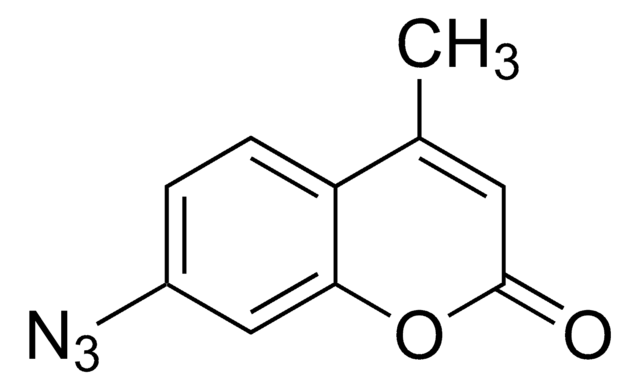69899
Monochlorobimane
suitable for fluorescence, ≥70.0% (HPCE)
Sinónimos:
mBCl, Chlorobimane
About This Item
Productos recomendados
Quality Level
assay
≥70.0% (HPCE)
form
powder
mp
135-136 °C (lit.)
solubility
DMF: soluble
DMSO: soluble
acetonitrile: soluble
methanol: soluble
fluorescence
λex 380 nm; λem 461 nm in methanol
λex 390 nm; λem 478 nm in 0.1 M phosphate pH 7.5 (after derivatization with glutathione)
suitability
suitable for fluorescence
SMILES string
CC1=C(C)C(=O)N2N1C(CCl)=C(C)C2=O
InChI
1S/C10H11ClN2O2/c1-5-7(3)12-8(4-11)6(2)10(15)13(12)9(5)14/h4H2,1-3H3
InChI key
SUIPVTCEECPFIB-UHFFFAOYSA-N
General description
Monochlorobimane, also known as mBCl, is a non-fluorescent compound that forms a fluorescent complex upon reaction. The fluorescence is detected at 394/490nm.
Application
Packaging
signalword
Warning
hcodes
Hazard Classifications
Eye Irrit. 2 - Skin Irrit. 2 - STOT SE 3
target_organs
Respiratory system
Storage Class
11 - Combustible Solids
wgk_germany
WGK 3
flash_point_f
Not applicable
flash_point_c
Not applicable
ppe
dust mask type N95 (US), Eyeshields, Gloves
Elija entre una de las versiones más recientes:
Certificados de análisis (COA)
¿No ve la versión correcta?
Si necesita una versión concreta, puede buscar un certificado específico por el número de lote.
¿Ya tiene este producto?
Encuentre la documentación para los productos que ha comprado recientemente en la Biblioteca de documentos.
Los clientes también vieron
Nuestro equipo de científicos tiene experiencia en todas las áreas de investigación: Ciencias de la vida, Ciencia de los materiales, Síntesis química, Cromatografía, Analítica y muchas otras.
Póngase en contacto con el Servicio técnico









